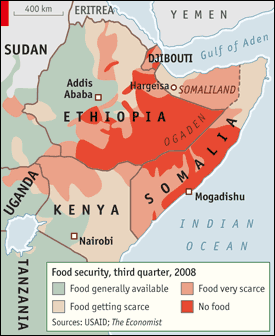The Horn of Africa has known its share of tragedies (including the long-running civil conflict in Somalia and war between Ethiopia and Eritrea). Those tragedies, however, are manmade and preventable. They begin in the hearts of scheming and evil people and wreak havoc on innocent victims. The Horn has also suffered from its share of famine and hunger. Some this suffering has also been manmade, but mostly it has been the result of natural causes. The people living there have the misfortune of living in an area where raising enough food is difficult even the best of times. Right now they are living through the worst of times. An article in The Economist wonders if this isn’t the tragedy of the decade [“The tragedy of the decade?” 01 November 2008 print edition]. In terms of sheer numbers, it could be if the past is prologue. The article recalls events in the area nearly a quarter of a century ago.
“One result of Ethiopia’s dreadful famine in 1984, when at least 1m people starved to death, was the invention of celebrity activism on behalf of the world’s most miserable. Band Aid, then Live Aid, then ever more sophisticated networking and the airing of films of starving children on television helped persuade rich countries’ governments to double aid to Africa as part of a wider set of promises to meet the UN’s eight Millennium Development Goals laid out in 2000, the first of which is to ‘eradicate extreme poverty and hunger’ by 2015. Despite progress in setting up early-warning systems, better procurement methods and the rapid delivery of nutrition in the form of foil packets of plumpy nut, the Horn of Africa has remained a hunger zone.”
Should another million people die of starvation in the Horn of Africa would eclipse the death toll in Darfur (estimated between 200,000 and 400,000 people). If the numbers rise higher than that (which they are not expected to do), the death toll could approach the casualty figures suffered in the greatest tragedy of the past twenty years; namely, the conflict in the Democratic Republic of the Congo. Fighting there has resulted in the estimated deaths of nearly 5.4 million people — and the fighting continues. The attached image (which accompanied the article) shows the area involved.

The number of “at risk” people in the Horn of Africa is staggering.
“The UN’s World Food Programme (WFP) says the present drought is the worst there since 1984. The International Committee of the Red Cross, which is usually slow to press the panic button, says it may be the tragedy of the decade. At least 17.5m people, the agencies reckon, may face starvation. The WFP is trying to feed 14m of them. High food prices, together with civil strife, the assassination of aid workers by jihadists, and piracy against food convoys sailing from Kenya to Somalia have combined with drought and desert to create a catastrophe. Some 12m of the hungry are in Ethiopia, 3m in Somalia, 2m in Kenya and Uganda, the rest in Eritrea and Djibouti.”
The good news for at-risk populations is that the international community knows better how to deal with mass starvation than it did twenty years ago. The bad news is that in a period of recession and high food prices knowing what to do and being able to do it are two different things.
“Aid workers are getting better at stopping mass starvation. Fewer people will die than in 1984 or 1992, when Somalia was famine-stricken. But doctors at feeding clinics in affected areas say that children are already dying of illnesses linked to malnutrition, such as diarrhoea, heart failure, pneumonia and other infections. Survivors may be physically and mentally stunted, and ravaged by sores. Fighting in Ethiopia’s Ogaden region and across Somalia makes it more expensive to reach the hungry. The WFP says it needs an extra $572m to keep people alive until April. Falling oil prices may reduce transport costs, but not by much. A shortage in the region’s markets has forced the WFP to buy most of its food from distant South Africa. An extra worry is that the world’s financial turmoil may reduce remittances from the Horn’s vast number of émigrés, putting more people at risk of starvation. The African Union, based in Addis Ababa, says a famine would wreck the region’s prospects and worsen general instability. Fighting between desperate pastoralist groups has already increased.”
None of this is good news for an area that has suffered for so long. The unfortunate truth is that the area shows little hope of breaking out of the vicious cycle that has kept it embroiled in conflict and tragedy for the past twenty years. It is likely that humanitarian relief efforts will be ongoing for years, while the development community sits hopelessly on the sidelines looking for opportunities to help the people to help themselves. There will be some bright spots in region (mainly in Kenya, Uganda and parts of Ethiopia) and efforts there should be supported. There will also remain some individual success stories. If there is any good news for the region, it is the fact that people there have shown remarkable resilience in the face of instability. What the area needs is long-term solutions for challenges they face and all of those solutions begin with security.




